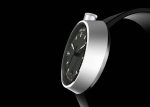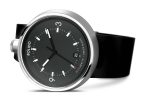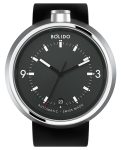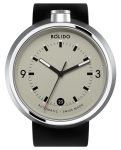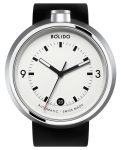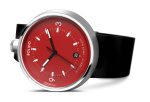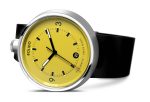Reviews
Bólido: A Meteoric Rise
Reviews
Bólido: A Meteoric Rise
Husslein bought his first real watch – the Ventura Watch by Flemming Bo Hansen – and his education in timepieces began as he methodically analysed the tiny square object, identifying its design principles and, in the process, finding his own position through reinterpreting the archetypes that were revealed to him. “I realised there was more to design than a very rational way of seeing things and at Hannes Wettstein I was able to explore beyond these reason-related scenarios,” he says.
Always a brand for “those who know”, the problems inflicted on the industry by the 2008 global market crash saw the gradual demise and eventual sale of Ventura, leaving in its wake pioneering designs such as Paolo Fancelli’s digital v-tec Zeta and Hannes Wettstein’s v-tec Kappa, both powered by the in-house calibre VEND04. And, although one of the most exciting design brands of our time, is no more in its original form, its maverick founder Pierre Nobs – never a man who was going to retire quietly – decided that today’s watch industry needed a kick into the 21st-century.
“Pierre and I developed a very special relationship – especially after Hannes died,” says Husslein. “I knew that Pierre had been consulting since his official retirement and earlier this year, out of the blue, he called me and said: ‘Simon we have to do something, and I have an idea.’” It turned out that Nobs was a little pre-occupied with the new Swiss-made rules and what this could do to the pricing of watches and he had settled upon the idea of using an automatic lathe machine to produce 100-per-cent Swiss-made watches without the associated high price-point.
Read more about Simon Husslein here.
The New Look
From a starting target of CHF 650 for the new watch, Husslein and Nobs knew that they had taken on a big challenge. “This is an attractive niche for newcomers to the watch world,” explains Husslein of the decision. “It meant that we needed to use an existing movement as well as hands and typefaces that were already available. In time, we might explore more customised and expensive alternatives, but we were determined to launch with a watch that stayed within new Swiss-made guidelines but at an entry price-point.”
The pair plumped for using an ETA 2824-compatible movement manufactured by STP, which has a far more elaborate finish and is regulated in five positions (versus three positions for the standard ETA). Fully Swiss with proven reliability, the movement provides for a good, basic calibre that can be dressed up for aesthetic purposes. Nothing new here, but the real innovation came in the creation of the case.
While auto lathes are not new to the watch industry, the process is uncommon, with the majority of Swiss watch cases today being moulded, which involves a multitude of additional tasks including cleaning, treating and polishing. The auto lathe, on the other hand, takes a solid tube of steel and machines a uni-body construction. Demonstrated to perfection by Apple, which uses the process to create laptop cases, you start with solid material and then machine out everything that’s not needed. But Nobs had one very important condition for Husslein: The case could not be “ordinary”.
1. The case would not be a simple cylinder. Instead it would be conical with the top having a smaller diameter to the bottom. This immediately gave the case design more life.
2. The case shape allowed Husslein to place the crown at 12 o’clock, a rarity in traditional cylinder cases as it makes watch too big.
3. Using exact proportions between the front to back was paramount – just 2/10ths of a millimetre off and the watch became too heavy or too light.
4. The watch case has no strap or band connectors – instead the strap is integrated into the underside of the case and hidden inside the base. This is only possible because of the monocoque construction, similar to 1960s Omega designs where cases are built from the outside in, and everything is inserted from the top. This has the added benefit of making the watch super-waterproof.
“You have to make a statement to establish yourself. The look seems bold because this is a micro brand, not an established company with an established look in its portfolio,” says Husslein. “Most existing brands had a bold look when they first came out but now those early watches are archetypes. Bólido means meteor in Spanish and the watch is a mix of our early discussions on colour, style, feel… everything. The idea was meteoric – bold, strong, geometric, it was always in our head when we discussed the concept.
“Bólido itself is a great word and is easy to say in all languages. This is an international watch – yes, it is Swiss-made but it is an international object. The word “Bólido” has rarely been used in the watch industry – just once, as far as we know, by Alain Silberstein who is a master of progressive design.”
Playing to the Crowd
As Bólido is a new brand, Husslein was seduced by the fact that there was no existing blueprint, allowing him to stretch his imagination. “Pierre and I had deep discussions about every detail,” he laughs. “It is so important to me to have a partner who cares as it means I have to fight for the things I really want, which makes them better. Pierre is a visionary who knows about marketing as well as the technical aspects of watchmaking and this is the reason we could make the watch so quickly. In fact we started our Kickstarter campaign and had raised the necessary funds in full within 16 hours.”
Surely one of the fastest-funded watch projects in history, what is it that crowdsourcing has added? “We deliberately didn’t want to have commercial investors, as it was important to keep the easy working relationship that Pierre and I have,” Husslein explains. “But we also knew that a successful Kickstarter campaign helps you to reach people that wouldn’t otherwise find you. We can reach out to the watch community later but through Kickstarter we can talk to people who wouldn’t necessarily be looking at a watch blog. I think it is a very valuable alternative in the sense that you can limit risk, you have additional audience and if you make a serious product as we did with partners and stories you stand out from other projects that are just copy and paste. A lot of our initial orders have come through the crowdsourcing.
“We had already built an awareness of the project – especially through the unofficial Ventura fan club,” says Husslein. “Also, I had my own network. We established a website – Bolido.Rocks – and populated it with early images, which we added to regularly as we progressed. We are currently doing the same for the various colours – pebble, yellow and red – to show them in detail and in lifestyle situations.”
The Future is Bright
The initial run of Bólido will be in the region of 500 pieces, although final numbers will depend on final Kickstarter interest. “We are not part of a group with a board, so we don’t have to decide everything today,” says Husslein. “We will definitely move on, but we have to wait and see the reaction of the market before we make our next plans. There is always the possibility that a launch will be a one-trick pony but I think Bólido’s foundations are good enough for the brand to live on.”
Tech Specs: Bólido
Movement
Automatic ETA 2824 regulated in five positions; 44-hour power reserve
Case
Surgical-grade stainless-steel case; water-resistant to 100m
Strap
Exclusive natural rubber strap; adjustable stainless-steel folding buckle





